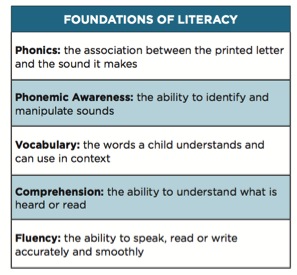written by Colleen Brunetti
One of the hottest topics in education today is that of literacy, or the ability to read and write fluently. Teachers and parents alike have a vested interest and heightened awareness of the need for strong early literacy skills in children and introducing them to sign language as a way to facilitate this learning process. The topic of sign language and literacy is something you will want to incorporate into your Signing Time classes and have a good working knowledge of, if you wish to collaborate with or sell to preschools and early elementary classrooms.
So what exactly is the reading part of literacy? It is actually more than just the idea of “reading”. Take a look at this chart (from our available guide entitled Enhancing Literacy Instruction) that reflects each facet.

Let’s break each of these down and look at how sign language can assist in the reading process. Each topic is hyperlinked to articles and activity ideas if you’d like to explore further.
Phonics is the area of reading that people tend to be most familiar with, and it has gotten a lot of attention in schools and through commercial programs sold to parents. While phonics is VERY important, make sure families understand that it makes up just one part of the reading process. To use sign language during the phonics acquisition phase, teach finger spelling. Since phonics is the association between the printed letter and the sound it makes, signing can assist this by providing a visual cue. For instance, children often think duh-bul-you (W) is more than one letter, but when they see the single sign, it provides a cue. Likewise, I will never forget the student I once had who was convinced that LMNO was a single letter. Adding signs while teaching the alphabet provides a cue that it is, in fact, four letters (and don’t forget to have some fun with the song LMNO from Signing Time’s Volume 5: ABC Signs).
Phonemic Awareness, or the ability to identify and manipulate (blend or segment) sounds, is a skill that often develops naturally through playing with words in rhymes and hearing lots of stories and songs. However, some children need a little boost in this area. Reading teachers have found that students who struggle with phonemic awareness will later struggle with learning to read. Play little games with the kids and use signing and finger spelling to help. For instance, you could say, “What is the word “HAT” without the H? Sign spell the word and the letter. When you sign the letter “H”, cover it with your hand or place it behind your back to show it is going away. The child should answer “AT” (once they catch on, which may take a few repetitions).
Vocabulary refers to the words a child knows. Sign language is fantastic for helping to build vocabulary because it often offers a visual representation of the word or concept that it represents (think of the sign for “POTTY” looking like shaking a toilet handle, or a “TREE” standing tall and straight, just like the object). Additionally, when you use sign to teach vocabulary, you are offering another dose of language. Children can see the word in print, say the word out loud, hear the word , and also sign the word to get a tactile representation. This is fantastic for children who learn best with multiple modalities or via multiple intelligences.
Comprehension is related to understanding. With struggling readers, comprehension is important because they may be missing meaning while trying to decode words. With advanced readers, comprehension often needs special attention as well, because they may be capable of actually reading more than they can understand. Like with vocabulary, sign language can be helpful with comprehension because it offers a sort of picture of words, reinforcing the concept a student is reading about.
Fluency refers to pace, accuracy, smoothness, and tone all coming together to be a pleasant oral reading or effective silent reading experience. The very best way to build fluency is through repeated readings of accurately leveled texts. Sign along with these repeated readings to continue to reinforce the concepts above.

Signing Time offers an Early Literacy Jump Start Bundle that you can share with your customers and pull from in your classes. In this bundle, you will find lots of ways to practice the ABCs. With the Story Time DVD, you can show parents how signing is literacy in action.
Above all, remind families that absolutely nothing can beat reading out loud to a child. All the teachers, degrees, enrichment classes, and activities in the world will never replace the value that comes from parents reading to their children every day. If they can sign along while they read aloud, so much the better!
